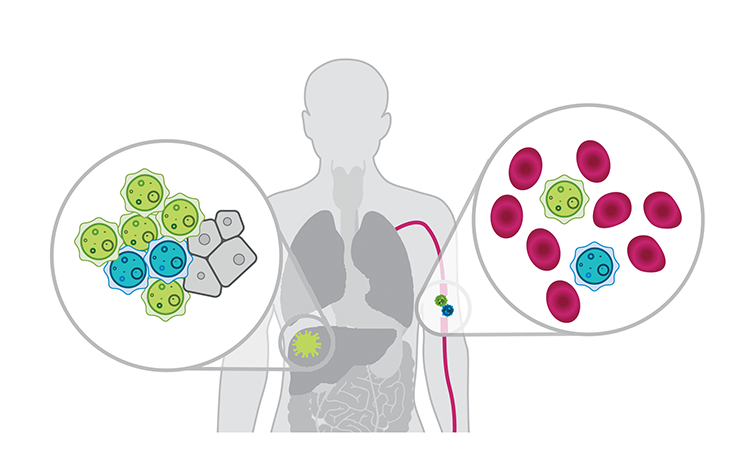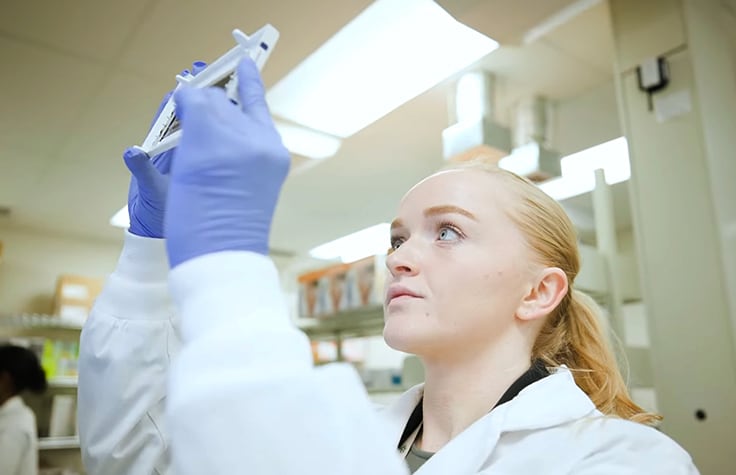Liquid Biopsy Research
Study biomarkers in liquid biopsies with NGS
Scientists can use liquid biopsy samples to detect and characterize various cancer-derived biomarkers present in the blood. These biomarkers are absent in healthy individuals and those who are cancer-free. Illumina offers innovative next-generation sequencing (NGS) liquid biopsy solutions for cancer biomarker research to analyze:
- Circulating tumor cells (CTCs)
- Cell-free DNA (cfDNA) and circulating tumor DNA (ctDNA)
- Cell-free RNA (cfRNA) and circulating tumor RNA (ctRNA)
- Circulating proteins for detection and profiling
Limitations of tissue biopsy
Several challenges limit the utility of tissue biopsy for use in translational and clinical cancer research, including:
- Inaccessibility of the tissue of interest
- Requirement for specialized skills from qualified medical personnel
- Invasiveness of repeat biopsies over time
- Limited representation of intra- and inter-tumor heterogeneity
- Patient ineligibility for physical biopsy due to significant procedural risk, insufficient quality or quantity of tissue, and other factors

What are circulating tumor cells (CTCs)?
CTCs are cells shed from tumors into the bloodstream. Multiple studies have demonstrated that CTCs have metastatic potential and are associated with aggressive or advanced disease and poor prognosis in various cancer types. While CTCs can serve as biomarkers for liquid biopsy-based cancer characterization, their rarity in the bloodstream (< 1 to < 50 CTCs in 7.5ml of blood on average) remains a significant challenge for detection and characterization. NGS-based technologies, which can detect low levels of CTCs with high throughput capabilities, are opening an exciting frontier for cancer screening and early detection.

Popular methods of CTC isolation involve:
- Enrichment of CTCs based on antigen expression, eg, epithelial cell adhesion molecule (EpCAM)
- Depletion of non-CTCs, such as blood cells and immune cells
- Leukapheresis
Technological advances in single-cell isolation and single-cell sequencing methodologies have enabled detailed analysis of single CTCs at the genomic, transcriptomic, and epigenomic levels. Combining liquid biopsy with single-cell sequencing of CTCs can elucidate the cellular heterogeneity that contributes to tumor biology.
Methylation patterns in cfDNA
Abnormal methylation patterns are a hallmark of many cancers. Changes in DNA methylation occur early during tumorigenesis and result in a state where most of the genome becomes hypomethylated and CpG islands become hypermethylated.
This switch in global methylation patterns leads to genomic instability and silencing of tumor suppressor genes, driving tumor progression and metastasis. Importantly, multiple studies have demonstrated that the methylation pattern of ctDNA recapitulates the pattern present in the cell/tissue of origin. This indicates that liquid biopsy analysis of ctDNA methylation can be used for early detection of cancer, analysis of tissue of origin, surveillance of minimal residual disease (MRD), monitoring therapy response, and more.
Cell-free RNA (cfRNA) and circulating tumor RNA (ctRNA)
cfRNAs can be released from multiple cell types present in the bloodstream as well as from cancer cells. These ctRNAs are potential biomarkers that can be assayed by liquid biopsy to identify specific cancers, detect cancer initiation, reveal tissue-of-origin, elucidate molecular mechanisms of disease, monitor therapeutic response, and more.
Unlike DNA, which is identical in every cell/tissue (except for genetic variants), RNA is dynamically and differentially expressed between cell types and tissues. This enables ctRNAs to be used to detect cancer and potentially localize it in the body. The diverse nature of RNA expression may also enable use of ctRNAs to determine and classify cancer subtypes early in disease, which is important given the wide range in progression, treatment options, and prognosis between cancers, even those associated with the same organ or tissue.
Short and long RNAs in liquid biopsy: How to sequence them and what they tell us about cancer
In this on-demand Illumina webinar, speakers discuss methodologies for sequencing long or short RNAs from liquid biopsy samples, along with implications for cancer research.

2023 Liquid Biopsy eBook: Circulating tumor cells, ctDNA, and cfRNA sequencing methods for liquid biopsy research
This 20+ page eBook provides published, comprehensive workflows for thorough characterization of liquid biopsy samples using NGS and microarrays.
- Overviews of liquid biopsy analytes
- Research examples, diagrams, and tables outlining every step of circulating tumor cell (CTC) sequencing, circulating tumor DNA (ctDNA) methylation profiling, ctDNA sequencing and cell-free RNA (cfRNA) sequencing
- Links to application notes, downloadable methods guides, and more resources
Recommended liquid biopsy research solutions
As a genomics technology leader, Illumina offers integrated workflows and innovative solutions that are validated for liquid biopsy analyte sequencing for cancer research.
| Sequencing focus | Library prep | Sequencing | Data analysis and visualization |
|---|---|---|---|
| Single-cell sequencing of CTCs | Multiple commercial offerings for genome, transcriptome, and epigenome | NovaSeq X System NovaSeq 6000 System NextSeq 1000 or NextSeq 2000 Systems |
DRAGEN Single-Cell RNA pipeline |
| cfDNA and ctDNA | TruSight Oncology 500 ctDNA v2 Illumina cell-free DNA Prep with Enrichment |
NovaSeq 6000 System | DRAGEN TruSight Oncology 500 ctDNA Analysis Software |
| Methylation patterns in cfDNA | Infinium MethylationEPIC BeadChip Kit | iScan System NextSeq 550 System |
GenomeStudio Bioconductor Software |
| cfRNA and ctRNA | Illumina RNA Prep with Enrichment | NovaSeq X System NovaSeq 6000 System NextSeq 1000 or NextSeq 2000 Systems |
DRAGEN RNA Pipeline |
Interested learning more about liquid biopsy for cancer research?
References
- Plaks V, Koopman CD, Werb Z. Circulating tumor cells. Science. 2013;341(6151) 1186-1188. doi: 10.1126/science.1235226.
- Cristofanilli M, Budd GT, Ellis MJ, et al. Circulating tumor cells, disease progression, and survival in metastatic breast cancer. N Engl J Med. 2004351(8):781-791. doi: 10.1056/NEJMoa040766.
- Huang J, Wang L. Cell-free DNA methylation profiling analysis-technologies and bioinformatics. Cancers (Basel). 2019;11(11):1741. doi: 10.3390/cancers11111741.
- Luo H, Wei W, Ye Z, Zheng J, Xu R. Liquid biopsy of methylation biomarkers in cell-free DNA. Trends Mol Med. 2021;27(5):482-500. doi: 10.1016/j.molmed.2020.12.011.
- Warton K, Lin V, Navin T, et al. Methylation-capture and Next-Generation Sequencing of free circulating DNA from human plasma. BMC Genomics. 2014;15(1):476. doi: 10.1186/1471-2164-15-476.
- Kopreski MS, Benko FA, Gocke CD. Circulating RNA as a tumor marker: detection of 5T4 mRNA in breast and lung cancer patient serum. Ann NY Acad Sci. 2001;945:172-178.
- Perhavec A, Cerkovnik P, Novakovic S, Zgajnar J. The hTERT mRNA in plasma samples of early breast cancer patients, non-cancer patients and healthy individuals. Neoplasma. 2008;55(6):549-554.
- Castellanos-Rizaldos E, Zhang X, Tadigotla VR, et al. Exosome-based detection of activating and resistance EGFR mutations from plasma of non-small cell lung cancer patients. Oncotarget. 2019;10(30):2911-2920. doi: 10.18632/oncotarget.26885.

